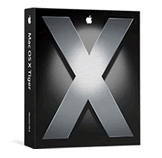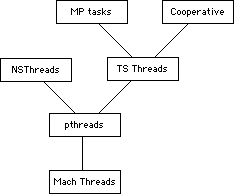No more mysteries: Apple's G5 versus x86, Mac OS X versus Linux
by Johan De Gelas on June 3, 2005 7:48 AM EST- Posted in
- Mac
Mac OS X: beautiful but...
The Mac OS X (Server) operating system can't be described easily. Apple:
While there are many very good ideas in Mac OS X, it reminds me a lot of fusion cooking, where you make a hotch-potch of very different ingredients. Let me explain.

Hexley the platypus, the Darwin mascot
Everything else is located in smaller programs, servers, which communicate with each other via ports and an IPC (Inter Process Communication) system. Explaining this in detail is beyond the scope of this article (read more here). But in a nutshell, a Mach microkernel should be more elegant, easier to debug and better at keeping different processes from writing in eachother's protected memory areas than our typical "monolithic" operating systems such as Linux and Windows NT/XP/2000. The Mach microkernel was believed to be the future of all operating systems.
However, you must know that applications (in the userspace) need, of course, access to the services of the kernel. In Unix, this is done with a Syscall, and it results in two context switches (the CPU has to swap out one process for another): from the application to the kernel and back.
The relatively complicated memory management (especially if the server process runs in user mode instead of kernel) and IPC messaging makes a call to the Mach kernel a lot slower, up to 6 times slower than the monolithic ones!
It also must be remarked that, for example, Linux is not completely a monolithic OS. You can choose whether you like to incorporate a driver in the kernel (faster, but more complex) or in userspace (slower, but the kernel remains slimmer).
Now, while Mac OS X is based on Mach 3, it is still a monolithic OS. The Mach microkernel is fused into a traditional FreeBSD "system call" interface. In fact, Darwin is a complete FreeBSD 4.4 alike UNIX and thus monolithic kernel, derived from the original 4.4BSD-Lite2 Open Source distribution.
The current Mac OS X has evolved a bit and consists of a FreeBSD 5.0 kernel (with a Mach 3 multithreaded microkernel inside) with a proprietary, but superb graphical user interface (GUI) called Aqua.
Performance problems
As the mach kernel is hidden away deep in the FreeBSD kernel, Mach (kernel) threads are only available for kernel level programs, not applications such as MySQL. Applications can make use of a POSIX thread (a " pthread"), a wrapper around a Mach thread.
Mac OS X thread layering hierarchy (Courtesy: Apple)
In order to maintain binary compatibility, Apple might not have been able to implement some of the performance improvements found in the newer BSD kernels.
Another problem is the way threads could/can get access to the kernel. In the early versions of Mac OS X, only one thread could lock onto the kernel at once. This doesn't mean only one thread can run, but that only one thread could access the kernel at a given time. So, a rendering calculation (no kernel interaction) together with a network access (kernel access) could run well. But many threads demanding access to the memory or network subsystem would result in one thread getting access, and all others waiting.
This "kernel locked bottleneck" situation has improved in Tiger, but kernel locking is still very coarse. So, while there is a very fine grained multi-threading system (The Mach kernel) inside that monolithic kernel, it is not available to the outside world.
So, is Mac OS X the real reason why MySQL and Apache run so slow on the Mac Platform? Let us find out... with benchmarks, of course!










116 Comments
View All Comments
tfranzese - Friday, June 3, 2005 - link
Kind of snappy there Johan.I do prefer numbers coming from one source myself.
JohanAnandtech - Friday, June 3, 2005 - link
Rubikcube: Speculative? Firstly, Both a webserver and a database server show terrible performance. Secondly, LMbench shows there is definitely a problem with creating threads. So everything point into our "speculative" conclusion.Thirdly, as mentioned in an earlier post:
http://www-106.ibm.com/developerworks/linux/librar...
is another indication that there is nothing speculative about our conclusion.
rubikcube - Friday, June 3, 2005 - link
#21 I disagree. Most of the end of the article on the threading problems was speculative. We can't say that's the cause without actual testing.Jalf - Friday, June 3, 2005 - link
To those wanting a Linux on G5 test, keep in mind the entire purpose of this article. It was to test the performance of a Mac computer running a Mac OS, compared to a Intel/AMD PC.So while installing Linux on the G5 would give us a better idea of how the CPU itself performs, it would also leave out the huge effect the OS also has (You wouldn't have seen the huge performance problems with threading, for example.)
Jalf - Friday, June 3, 2005 - link
#11: Not true, if you browse AMD's documentation for a bit, they do say that their TDP *is* the absolute max power.Intel uses the "maximum power achievable under most circumstances"-method though.
rubikcube - Friday, June 3, 2005 - link
I agree that linux should have been used for a more normalized comparison. I also think that you should have tried running your mysql tests from darwin on x86. You might have been able to find the cause of the performance anomalies.Sabresiberian - Friday, June 3, 2005 - link
I find it hilarious that someone calling him- or herself 'porkster' is complaining about someone else's language :)Apple's computers have made their fame on their user-friendliness, so I think it is very appropriate to compare these computers with OSX on the Apples, as that's where the user-friendliness resides and both OSes are in the same family. It would have been fun to compare using the 64 bit Win XP Pro - I bet we would all get a good laugh out of that. Microsoft is determined, I think, to make a Linux man out of me yet :)
kresek - Friday, June 3, 2005 - link
waiting for AnandTech's YDL results, have a look at this:http://www-106.ibm.com/developerworks/library/l-yd...
SMOG - Friday, June 3, 2005 - link
#13 Thresher: "When it comes down to it, performance is important, but not the only reason people buy what they buy. I would say more often than not, the decision is made with only a modicum of logic."Your right, and those people didn't read this article, at best they read the first page then skipped to the last to see if he bashed Apple or not. This article was for those who want to know just what the power of the PowerPC actually is. This is a technical artical, not a buyers guide. This is science.
Good Job.
CU - Friday, June 3, 2005 - link
You mentioned most people don't use the Intel compiler, but it would have been nice to see it and also the windows compiler and the ibm compiler.